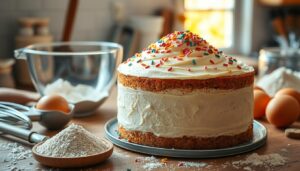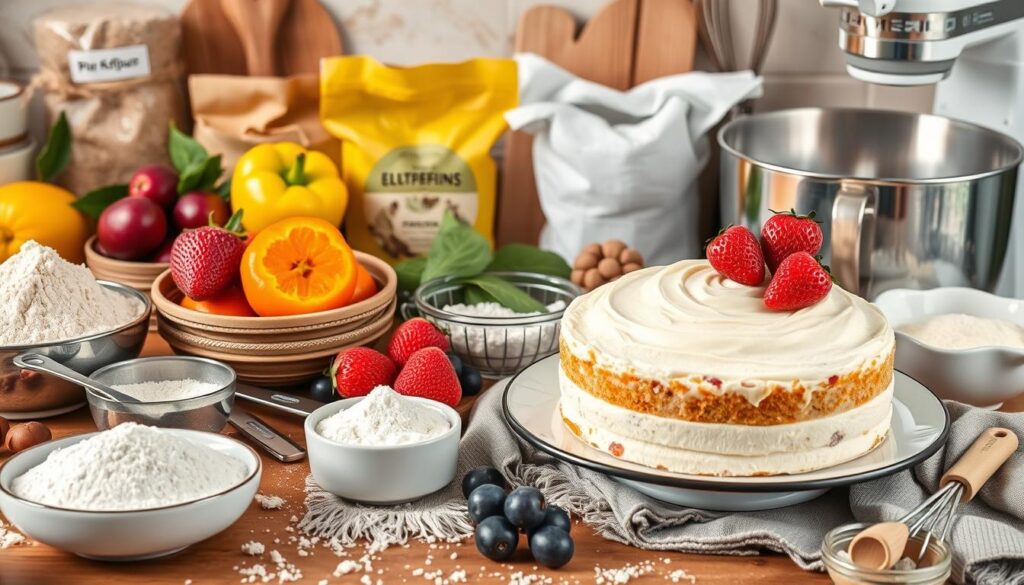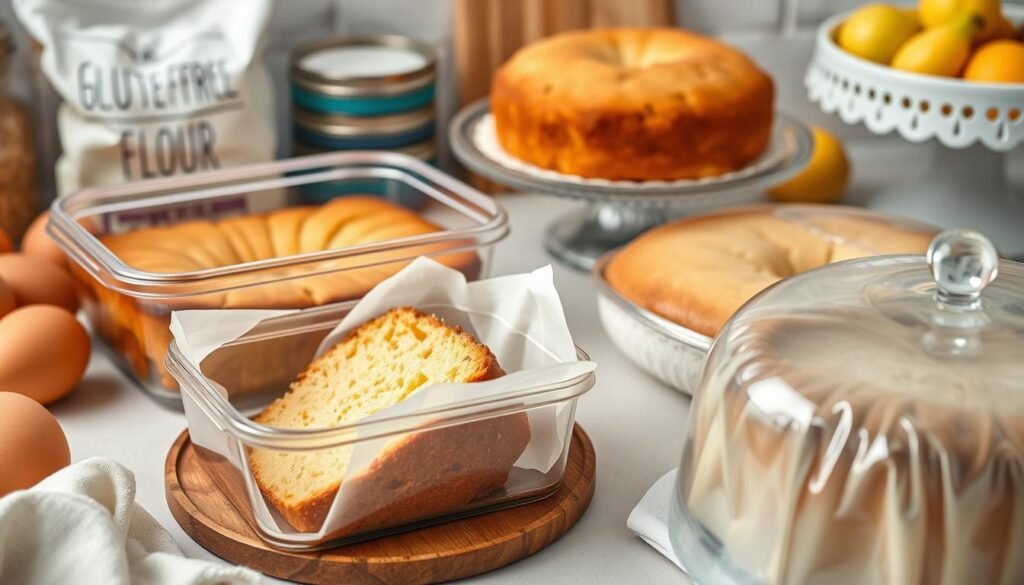The Best Fluffy Pancakes recipe you will fall in love with. Full of tips and tricks to help you make the best pancakes.

Imagine pulling a perfectly golden, soft gluten-free cake from the oven. This dream was once impossible, especially for those on a celiac diet. But now, thanks to modern baking, making moist and delicious gluten-free cakes is easier than ever.
This guide will change how you bake, teaching you to make gluten-free cakes that taste just like the real thing. Whether you’re following a special diet or just want to try something new, you’ll learn how to make amazing cakes at home.
Gluten free cake is the perfect choice for anyone with gluten intolerance who still wants to enjoy a moist and delicious dessert
Table of Contents
Understanding Gluten Free Cake Fundamentals
Exploring gluten-free cakes opens a world of baking fun. It’s not just about avoiding wheat. It’s an art that needs precision, creativity, and knowledge of new ingredients.
What Makes a Cake Gluten-Free
A gluten-free cake is different from regular cakes. It doesn’t use wheat-based flour. The main parts of gluten-free desserts are:
- Alternative flour blends (like rice, almond, coconut)
- Special binding agents
- Unique ways to keep moisture
Benefits of Gluten-Free Baking
Baking gluten-free cakes has many health benefits:
- It’s easier to digest
- You can use nutrient-rich ingredients
- There are many flavors to try
| Flour Type | Protein Content | Moisture Absorption |
|---|---|---|
| Almond Flour | 8g per 1/4 cup | Standard moisture |
| Coconut Flour | 3g per 2 tbsp | 4x weight in liquid |
| Rice Flour | 2g per 1/4 cup | Moderate absorption |
Common Challenges in Gluten-Free Baking
Creating perfect gluten-free desserts can be tricky. Bakers face issues like texture and moisture. Most recipes need exact measurements and special techniques.
“Gluten-free baking is an adventure of flavors and textures waiting to be mastered.” – Baking Expert
By learning these basics, you can make gluten-free cakes amazing. You’ll create treats that everyone will love.
Essential Ingredients for Perfect Texture
To make a tasty gluten-free cake, you need to know the key ingredients. These ingredients are what make allergy-friendly baking work. They help your cake stay moist and have the right structure.
- Gluten-free flour blend
- Xanthan gum
- Moisture-rich ingredients
- Leavening agents
“The secret to great allergy-friendly baking is understanding how ingredients interact”
Now, let’s look at the important ingredients for a gluten-free cake:
| Ingredient | Purpose | Quantity |
|---|---|---|
| Gluten-Free Flour Blend | Provides structure and base | 2 ½ cups (300 grams) |
| Xanthan Gum | Replaces gluten’s binding properties | 1-2 teaspoons |
| Vegetable Oil | Adds moisture and softness | ½ cup (118 ml) |
| Sour Cream | Enhances richness and texture | 1 cup (227 grams) |
In allergy-friendly baking, precision matters. Each ingredient is vital for a moist, fluffy cake. Knowing these ingredients helps you become a pro at gluten-free cake baking.
Best Gluten-Free Flour Blends for Baking
Finding the right gluten-free flour blend is key to baking success. There are many options, each with its characteristics. Knowing these differences is essential for making tasty treats.
Expert bakers suggest several top gluten-free flour blends. These blends can elevate your baking from good to great.
Top Commercial Flour Blend Recommendations
- Bob’s Red Mill 1:1 Baking Flour
- King Arthur Measure-for-Measure Flour
- Cup4Cup Multipurpose Flour
| Flour Blend | Price | Key Characteristics |
|---|---|---|
| Cup4Cup | $17 for 3 pounds | Puffy, golden, soft texture |
| Bob’s Red Mill | $12 for 3 pounds | Versatile all-purpose blend |
| King Arthur | $15 for 3 pounds | Consistent baking performance |
Understanding Xanthan Gum’s Critical Role
Xanthan gum is crucial in gluten-free baking. It helps bind ingredients like gluten does. Without it, gluten-free cakes can be crumbly and fall apart. Bakers usually add about 1/2 teaspoon per cup of flour for the best texture.
Precision in Flour Measuring
Measuring flour accurately is vital in gluten-free baking. Use the spoon and level method. Spoon flour into cups and level it with a straight edge. This method avoids compacting flour and ensures consistent results.
“The secret to great gluten-free baking is understanding your ingredients” – Thomas Keller
The Secret to Moisture and Fluffiness
Making the perfect gluten-free cake is all about moisture and texture. It’s important to pick the right ingredients. This way, you can turn a dry cake into a soft and tender treat.
To get that fluffy texture, choose your ingredients wisely. Here are some tips for making moist and healthy cakes:
- Replace traditional butter with a combination of oil and sour cream
- Use room temperature ingredients for better blending
- Incorporate extra moisture through carefully selected ingredients
“Moisture is the secret weapon in gluten-free baking” – Gluten-Free Baking Experts
It’s key to know how gluten-free flours work with moisture. They soak up more liquid than wheat flour. So, you need to adjust your recipe. Letting your batter rest for 30 minutes before baking helps.
Here are some ways to add moisture to your cakes:
- Use ⅓ cup of oil instead of solid butter
- Add ½ cup sour cream to enhance richness
- Include 4 large room-temperature eggs
Pro tip: Use a scale to measure your ingredients. This method ensures the right moisture and makes your cake fluffy.
Professional Tips for Cake Texture
Mastering gluten-free baking needs precision and knowing how ingredients behave. Your success in making tasty gluten-free cakes depends on several key factors. These factors turn simple recipes into amazing culinary experiences.
Temperature Matters in Gluten-Free Baking
Using room temperature ingredients is key for the perfect gluten-free cake texture. Eggs, butter, and milk should sit at room temperature for 30-45 minutes before mixing. This step ensures even ingredient distribution and helps make a smoother batter.
Smart Mixing Techniques
Gluten-free baking needs special mixing strategies because of the lack of wheat protein. Here are some professional techniques:
- Mix ingredients well to activate binding properties
- Avoid overmixing to prevent dense textures
- Use a stand mixer or hand mixer for even mixing
- Let the batter rest for 10-15 minutes before baking
Baking Time Adjustments
Gluten-free cakes bake differently than traditional ones. Keep an eye on your cake and be ready to adjust baking times.
| Flour Type | Recommended Baking Temperature | Typical Baking Time |
|---|---|---|
| Almond Flour | 325°F | 25-30 minutes |
| Rice Flour | 350°F | 30-35 minutes |
| Coconut Flour | 325°F | 35-40 minutes |
Pro tip: Always use an oven thermometer to ensure accurate temperature and prevent uneven baking in your gluten-free creations.
By using these professional gluten-free baking techniques, you’ll make cakes with amazing texture, moisture, and flavor. These cakes will be just as good as those made with wheat.
Mastering the Baking Process
Baking gluten-free cakes needs precision and special techniques for a delicious result. When making celiac diet recipes, it’s key to understand gluten-free baking challenges. This ensures the perfect texture and flavor.

- Allow batter to rest for 30 minutes before baking
- Use an oven thermometer to ensure accurate temperature
- Check cake doneness with a toothpick test
- Measure ingredients precisely
Xanthan gum is crucial in gluten-free baking. About 1 teaspoon per cup of gluten-free flour prevents crumbling. It gives the structure gluten provides.
“The secret to a perfect gluten-free cake lies in understanding how alternative flours behave during baking.”
Here are some professional tips for celiac diet recipes:
- Combine multiple gluten-free flours for better texture
- Use room temperature ingredients
- Mix wet and dry ingredients thoroughly
- Avoid overmixing the batter
Temperature control is key. Most gluten-free cakes bake best at 325-350°F. This prevents dryness and ensures they’re fully cooked. By using these techniques, you’ll make moist, fluffy cakes for everyone to love.
Making Your Cake Dairy-Free
Creating dairy-free vegan cakes doesn’t mean losing flavor or texture. The right ingredients and techniques can turn traditional recipes into tasty dairy-free cakes. These are loved by all.
The demand for inclusive desserts has made dairy-free baking easier than ever. About 25% of consumers now look for dairy-free options. It’s important to know how to change your favorite recipes.
Dairy-Free Ingredient Substitutions
Replacing dairy in your cakes is simpler than you think. Here are some great alternatives:
- Plant-based milk (almond, oat, coconut)
- Vegan butter substitutes
- Coconut cream
- Dairy-free sour cream alternatives
Adaptation Techniques for Dairy-Free Baking
When making recipes dairy-free, keep these tips in mind:
- Use 1 cup of dairy-free milk with 1 teaspoon apple cider vinegar to make vegan buttermilk
- Replace butter with coconut oil or vegan butter in equal amounts
- Try different plant-based milks to find your favorite taste
“The best dairy-free cake is one that nobody can tell is dairy-free!” – Vegan Baking Expert
With people willing to pay more for special dietary options, it’s worth perfecting your dairy-free cake recipes. Remember, practice makes perfect. Each try brings you closer to making a delicious, inclusive dessert.
Perfect Frosting Combinations
Making the perfect frosting for your gluten-free cake can turn a simple dessert into a special treat. Choosing the right ingredients is key for allergy-friendly baking. This ensures your cake tastes great and feels just right.
When looking for frosting, think about these tasty options that go well with your gluten-free cake:
- Vanilla Buttercream: Classic and versatile
- Chocolate Frosting: Rich and decadent
- Fruit-Based Spreads: Light and refreshing
- Whipped Cream Frostings: Delicate and smooth
“The right frosting can elevate a good gluten-free cake to an unforgettable dessert experience.”
For your allergy-friendly baking journey, here’s a look at frosting ingredients:
| Frosting Type | Key Ingredients | Preparation Time |
|---|---|---|
| Vanilla Buttercream | Softened butter, powdered sugar, vanilla extract | 10 minutes |
| Chocolate Frosting | Cocoa powder, butter, powdered sugar, milk | 15 minutes |
| Whipped Cream Frosting | Heavy cream, powdered sugar, vanilla extract | 8 minutes |
Here are some tips for making frosting that’s safe for allergies:
- Use room temperature ingredients
- Sift powdered sugar to prevent lumps
- Adjust milk quantity for desired consistency
- Taste and adjust sweetness as needed
Pro tip: For a dairy-free alternative, replace butter with coconut cream or plant-based margarine to maintain that creamy texture.
Storage and Freshness Tips

Keeping your gluten-free cake fresh is key. The right storage can make each slice as tasty as the first. Here are some tips to help you.
Room Temperature Storage
Gluten-free cakes don’t last as long as regular ones. They stay fresh for 1-2 days at room temperature. Use an airtight container to keep moisture in and texture intact.
Refrigeration Strategies
Refrigeration can extend your cake’s life. But, it needs careful handling. Wrap it tightly in plastic wrap to avoid drying out. Store it between 15-25°C and eat within three days for best results.
Freezing Techniques
- Wrap cake layers individually in plastic wrap
- Place in a freezer-safe container
- Freeze for up to three months
- Thaw overnight in the refrigerator
“The secret to a perfect gluten-free cake is not just in baking, but in careful storage.” – Baking Expert
| Storage Method | Duration | Best Practices |
|---|---|---|
| Room Temperature | 1-2 days | Airtight container |
| Refrigerator | 3-4 days | Tightly wrapped |
| Freezer | Up to 3 months | Individual wrap, freezer-safe container |
Pro tip: Adding a slice of bread to your storage container can help absorb excess moisture. This keeps your gluten-free cake fresher for longer.
Common Baking Mistakes to Avoid
Baking wheat-free cakes can be tricky, especially for beginners. Knowing common mistakes helps you make delicious, perfectly textured cakes every time.
Temperature Challenges in Gluten-Free Baking
Temperature is key to making great wheat-free cakes. Cold ingredients can mess up the texture and rise. Professional bakers say to bring eggs and butter to room temperature before mixing.
- Use room-temperature eggs for better incorporation.
- Warm butter to soften before mixing
- Preheat your oven precisely to the recipe’s specified temperature
Mixing Technique Mistakes
Overmixing can make wheat-free cakes dense and tough. Gluten-free flours need a gentle touch to keep their structure.
“Two minutes of mixing is typically the sweet spot for achieving the perfect wheat-free cake batter,” says America’s Test Kitchen expert.
Ingredient Ratio Precision
Wheat-free cakes need exact ingredient measurements. Small changes can greatly affect the final product. Using a kitchen scale ensures consistent results in your wheat-free cake recipes.
- Weigh flour in grams, not ounces.
- Measure liquid ingredients at eye level.
- Use precise measuring tools.s
Avoiding these common mistakes will help you make moist, delightful wheat-free cakes. Everyone will love them.
Decorating Your Gluten-Free Cake
Turning your grain-free desserts into stunning works of art is easy. You don’t need special skills. With the right techniques, you can make beautiful cakes that taste as good as they look. Decorating gluten-free cakes is fun and rewarding, whether you’re new or experienced.
Professional decorators share some key tips for amazing results:
- Start with a smooth crumb coat to seal in cake crumbs
- Use gluten-free fondants like Satin Ice or Wilton
- Invest in quality piping bags and tips
- Ensure all decorating ingredients are certified gluten-free
When using fondant for grain-free desserts, temperature is crucial. Keep your workspace cool and work fast to avoid sticking. Dust your surface with powdered sugar or cornstarch to manage texture.
“The art of cake decorating is about creativity, precision, and passion” – Professional Baker
Piping techniques can make your cake go from simple to spectacular. Practice patterns like rosettes, shells, and borders. For detailed designs, use room-temperature buttercream and keep your piping bag steady.
With practice, your gluten-free cakes will look like they were done by a pro. And they’ll still be safe for those with gluten sensitivities.
Conclusion
Exploring healthy cake alternatives is a fun journey into culinary creativity. The gluten-free foods market is booming, growing at 8.7% each year. You’re part of a growing community of bakers who are changing desserts.
Gluten-free baking is more than just a diet choice. It’s a chance to try new ingredients and techniques. By learning about flour blends, keeping things moist, and improving texture, you can make amazing cakes.
These skills aren’t just for making one cake. They apply to many gluten-free baked goods. Whether you bake for health reasons or just for fun, you’re ready to experiment. Trust yourself and enjoy the tasty results of your gluten-free baking.
With time and effort, you’ll get better at baking and find new, healthy cake options. Gluten-free baking is full of possibilities. It’s waiting for you to explore, create, and celebrate.
FAQ
What makes a cake gluten-free?
A gluten-free cake uses flour without wheat, barley, or rye. It often includes rice flour, almond flour, coconut flour, or gluten-free mixes. These flours replace wheat to keep the cake’s taste and texture.
Can I make a gluten-free cake that tastes as good as a regular cake?
Yes, you can! The right ingredients and methods make gluten-free cakes just as tasty. Use the right flour mix, add moisture with oil or sour cream, and include xanthan gum for structure.
What is xanthan gum, and why is it important in gluten-free baking?
Xanthan gum is key in gluten-free baking. It helps with texture and prevents crumbling. It’s like gluten but for gluten-free cakes.
How can I prevent my gluten-free cake from becoming dry?
To avoid dryness, add moisture with oil, sour cream, or Greek yogurt. Choose a flour mix with starches. Let the batter rest and avoid overbaking. Applesauce or mashed banana can also help keep it moist.
Are all gluten-free cakes automatically dairy-free?
No, gluten-free and dairy-free are different. Gluten-free cakes can still have dairy like butter or milk. But, you can make them dairy-free by using plant-based alternatives.
What are the best gluten-free flour alternatives?
Great alternatives include almond flour, rice flour, coconut flour, and sorghum flour. A blend is often best for texture and flavor.
How long can I store a gluten-free cake?
Store a gluten-free cake at room temperature for 2-3 days. In the fridge, it lasts 5-7 days. Freeze for up to 3 months. Always wrap it well to keep it fresh.
Can I decorate a gluten-free cake like a regular cake?
Yes, you can decorate gluten-free cakes like traditional ones. Just make sure your frosting, fondant, and sprinkles are gluten-free. Most decorating techniques work the same.









